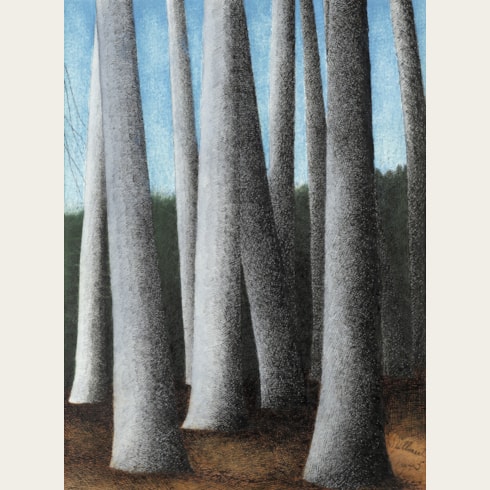Léon SPILLIAERT
(Ostend 1881 - Brussels 1946)
Seascape with White Sails
Sold
Gouache, watercolour and pastel on paper.
Signed and dated L. Spilliaert / 1922 at the lower right.
510 x 740 mm. (20 1/8 x 29 1/8 in.)
Signed and dated L. Spilliaert / 1922 at the lower right.
510 x 740 mm. (20 1/8 x 29 1/8 in.)
This large sheet may be included among a group of powerful seascapes in watercolour and gouache produced by Spilliaert in the 1920’s and early 1930’s. Comparable drawings, executed in pure gouache or a combination of gouache, pastel and watercolour, are in the Royal Museums of Fine Arts of Belgium and in several private collections. These works, in which the sea sometimes takes on an almost abstract quality, show the artist’s interest in light effects and nuances of colour, with a human presence signified only by distant boats.
As early as 1912, the French critic François Jollivet-Castelot, one of the artist’s first critical advocates, noted of the young painter that ‘His art communicates, above all, the vertigo of the infinite. When he paints a seascape, it is as if, there in front of you, is the endless ocean with its mysterious waves, the monotonous beach and a sky which becomes one with the sea in the distance…Here there is no affectation, no prettiness or graciousness; Spilliaert’s style remains untiringly grand, beautiful, simple – as large as nature herself.’ Such critical assessment of Spilliaert’s marine subjects has continued to the present day, with one modern Belgian writer noting that ‘Spilliaert’s reputation also continues to shine because of a few seascapes. His better seascapes…are among the strongest images ever made of our coastline and sea. If the sea could choose its own portraits, it would want these.’
As early as 1912, the French critic François Jollivet-Castelot, one of the artist’s first critical advocates, noted of the young painter that ‘His art communicates, above all, the vertigo of the infinite. When he paints a seascape, it is as if, there in front of you, is the endless ocean with its mysterious waves, the monotonous beach and a sky which becomes one with the sea in the distance…Here there is no affectation, no prettiness or graciousness; Spilliaert’s style remains untiringly grand, beautiful, simple – as large as nature herself.’ Such critical assessment of Spilliaert’s marine subjects has continued to the present day, with one modern Belgian writer noting that ‘Spilliaert’s reputation also continues to shine because of a few seascapes. His better seascapes…are among the strongest images ever made of our coastline and sea. If the sea could choose its own portraits, it would want these.’
The son of a wealthy perfumer, Léon Spilliaert from an early age suffered from acute anxiety, stomach disorders and insomnia. An introspective and sensitive youth, he would wander the deserted streets, quays and beaches of his native Ostend throughout the evening, and in later years produced countless drawings, pastels and watercolours of the fog-bound city at night. Having shown a talent for drawing from an early age, Spilliaert was largely self-taught as an artist, his only formal training being a few months at the Academy in Bruges. At the age of twenty-one he was employed by the publisher and collector Edmond Deman as an assistant, and settled in Brussels. Deman was to become the young Spilliaert’s mentor and champion, nurturing his talent and introducing him to the flourishing artistic scene in Brussels. At the end of January 1904 Spilliaert travelled to Paris, bearing a letter of introduction from Deman to the Belgian poet Emile Verhaeren, who bought some of Spilliaert’s works and further encouraged him. After a few months he returned to Ostend, although he would travel to Paris each winter for several years.
Only a handful of local collectors were aware of Spilliaert’s work, and it was not until 1908 and 1909 that he first exhibited his drawings in public. By the end of 1909 one art critic had described him in an Ostend newspaper as ‘still almost unknown, shrouded in proud modesty and disdainful of advertising, the young Oostende aquarellist Léon Spilliaert is a great, a very great artist.’ Spilliaert continued to take part in local exhibitions, and became a member of several artists groups, alongside such painters as James Ensor and Constant Permeke. By 1912 Spilliaert had become better known, and was invited to take part in a number of avant-garde exhibitions. In 1920, along with Ensor, Permeke and Gustave de Smet, he became a founder member of the Sélection group in Brussels, exhibiting regularly with them and contributing covers and illustrations to its magazine. Apart from a few years in Brussels, he spent most of his career in Ostend, and views of the port town and its surrounding coastline came to dominate his output.
Léon Spilliaert remains best known today as a virtuoso draughtsman, and indeed drawings were his chief mode of expression throughout his career. Executed in pastel, gouache, Indian ink and wash or watercolour, his drawings are remarkable examples of original and inventive visual imagery that can perhaps best be described as Symbolist. The subject matter of his drawings included urban views – almost always depicted at night, and usually devoid of people - landscapes and seascapes, interiors, still-lives and, not least, a series of intensely introspective self portraits.
Provenance
Anonymous sale, Amsterdam, Christie’s, 10 October 2000, lot 70
Galerie Lambert Tegenbosch, Heusden aan de Maas.






